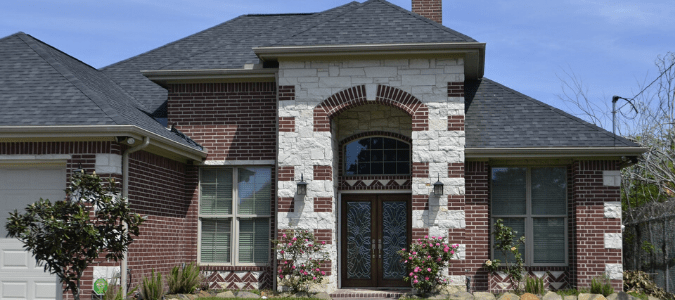Many types of siding can withstand the pressure of power washing and benefit from this kind of cleaning. For example, fiber cement, vinyl and modern wood clapboard siding are typically strong enough for pressure washing. However, it’s best to avoid using a pressure washer on any surface with lead paint or on homes with aluminum or shingle siding, as these materials could dent or break loose.
Even for siding that can withstand this kind of pressure, it’s wise to use caution with any power washing job. If you use a machine that’s too powerful, use a pressure setting that’s too high or stand too close to your house, then you might end up damaging your siding or even the structure of your home. Plus, you could injure yourself.
That’s why it’s easiest to hire a professional instead of trying to handle pressure washing on your own. These pros have the skills and tools needed to keep your home looking clean and beautiful. All while avoiding the pitfalls that can come with a pressure washing project gone wrong.
If you decide to tackle this project on your own, it’s wise to follow these steps to reduce risks to your home.
Before Getting Started
Before you get started, it’s a good idea to prepare the area you’ll be washing and collect all the tools you’ll need. This will help improve the efficiency of your project. It will also help reduce the likelihood that you’ll mistakenly hurt yourself or someone else.
Gather Your Tools
The first step is choosing what kind of equipment you want to use. There are several kinds of pressure washers on the market, which are made for different surfaces and types of power washing projects. If you use the wrong kind of pressure washer, you might damage the surface you’re trying to clean.
Topline power washers are expensive, so you might consider renting one instead of buying this kind of machine. However, it’s important to keep in mind that rented tools might not have been taken care of. They might have broken parts or corrosion inside the machine, which can reduce the pressure coming out of the washer or cause it to spray erratically. It’s time-consuming and frustrating to use this kind of under-performing machine.
Beyond the power washer itself, you’ll also need a cleanser. Avoid using a corrosive cleaning solution, such as those with straight bleach. Instead, use a detergent that’s approved for pressure washing or a solution of soap and water. For tough spots like those with a lot of dirt or that haven’t been cleaned in a while, you might also need to use a utility or rotating brush on the end of the power wash wand. These tools can help loosen the dirt.
Additionally, you might also need some other tools as well. For example, if you’re trying to power wash the second story of your home, you should avoid using a ladder. Instead, you might need a more powerful pressure washer, a telescoping wand or an extension wand.
Grab Your Gear
High-pressured water can pierce through your skin and thick surfaces. This is why you should protect yourself while working on this type of project. Proper protective gear for power washing includes pants and a long-sleeved shirt, as well as steel-toed boots, eye protection, hearing protection and gloves.
Prep Your Work Area
Before you start power washing, take care to replace or repair missing or damaged siding. Also, close doors and windows in the area where you’ll be cleaning. Then, tape plastic over external electrical fixtures or outlets in the area. It’s also good to trim and cover any plants in the area to help protect them from damage. To prevent tripping, remove any other obstacles that might get in your way while you’re working.
Safety Tips
Once you have your work area set up, review the instructions for your power washer. Some things to keep in mind for any kind of power washer are to avoid directly spraying vents, eaves or light fixtures. This is because the high pressure could break them or knock them loose.
Point the power washer wand down onto the surface that you’re spraying to avoid pointing pressure into the more vulnerable spots on horizontal siding that could break with this pressure. Also, avoid spraying water into gaps around siding runs, doors or windows. If something does break, even small spots of damage could turn into a breeding area for mold.
Additionally, never point the pressure washer at people, animals or power sources. It’s also smart to stand on a stable surface when using a power washer, and never leave the washer unattended when it’s turned on.
Power Washing Your Siding
With the above safety tips in mind, you can start your project using the following steps.
- Make sure to use a lower water pressure setting—at least when you begin your project. Otherwise, you could do more harm than good by damaging the surface of your siding or by getting water behind your siding. After all, most pressure washers can damage concrete because they’re so powerful. To do this, set the wand at the most dispersed pressure and slowly increase the pressure. Most power washers have settings that range from the highest pressure at 0 degrees (a very fine point of concentrated power) to a more dispersed pressure at around 40 degrees or more.
- To begin spraying, start at a spot that’s at least five feet away from your siding, and gradually get closer or slightly increase pressure as needed. First, test a small, out-of-the-way part of your house to make sure your siding can handle the pressure of your washer. If the test goes well, you can proceed with your project.
- Start from the bottom of your home and work your way to the top. Use a low pressure setting on your washer to apply the detergent or soap solution with smooth and overlapping strokes
- It’s best to let the soap rest for five to ten minutes to let the solution set. If the sun is shining on your house while you’re washing, make sure that the cleaning solution doesn’t dry out.
- After the cleaning solution has had a chance to rest, rinse off the soap or detergent. Start at the top of your house and work downwards in small sections to remove all the cleaning solution.
- Once you’re done washing the siding, follow the manufacturer’s instructions for your washer to relieve pressure from the pump and drain any excess water and detergent before you store the machine.
Now that you know how to power wash your siding, you probably have a few follow-up questions. For example, how often should you be power washing your home? And, can you power wash your windows? Keep reading to find out.
How Often Should You Pressure Wash Your House?
On average, you should only need to power wash your home about once every two years. However, you might choose to get this service done more often to keep your home looking clean. Beyond a personal preference, your home’s surface might also need cleaning more frequently because of a few different factors.
For example, pollen from trees can leave a sticky yellow coating on everything in your yard, including your siding and patio. Additionally, moss can grow on areas of your home that don’t get frequent exposure to direct sunlight. Other environmental conditions can also cause dirt and grime to build up on your home’s exterior, such as heavy winds. This is especially a concern if you live near new construction or areas with lots of trees.
No matter how often you choose to clean your siding, you don’t have to deal with it yourself. Pressure washing a house can be time-consuming and messy for homeowners who try to do it on their own. Professional service providers perform this service year-round, so you don’t have to deal with it. They can tackle other areas of the home too, so you don’t have to learn how to power wash your deck or other surfaces.
Can You Power Wash Windows?
You can power wash windows, but it’s not always recommended. For one, power washing can damage windows and window frames. Also, water can enter through gaps, which can lead to mold growth and further damage around your home. That’s why it’s usually wisest to clean windows another way. That said, any type of window washing process can involve difficult, time-consuming work.
This is because thorough window washing typically involves climbing ladders and scrubbing windows inside and out. However, you don’t have to tackle this dirty project all on your own. Home service providers often offer window washing services along with power washing. A professional can help get your windows and siding sparkling clean. They have the skills and experience needed to clean your home and make sure the cleaning process doesn’t do more harm than good.
ABC Can Get Your Home Nice and Clean
Instead of learning how to clean your home yourself (and getting dirty in the process), contact ABC Home & Commercial Services. We offer a variety of exterior cleaning services, including power washing, gutter cleaning and window cleaning. When you contact us, you can have peace of mind that we will get your home clean without damaging your property. This way, you don’t have to worry about pulling out your ladder or learning how to clean your gutters from the ground.


